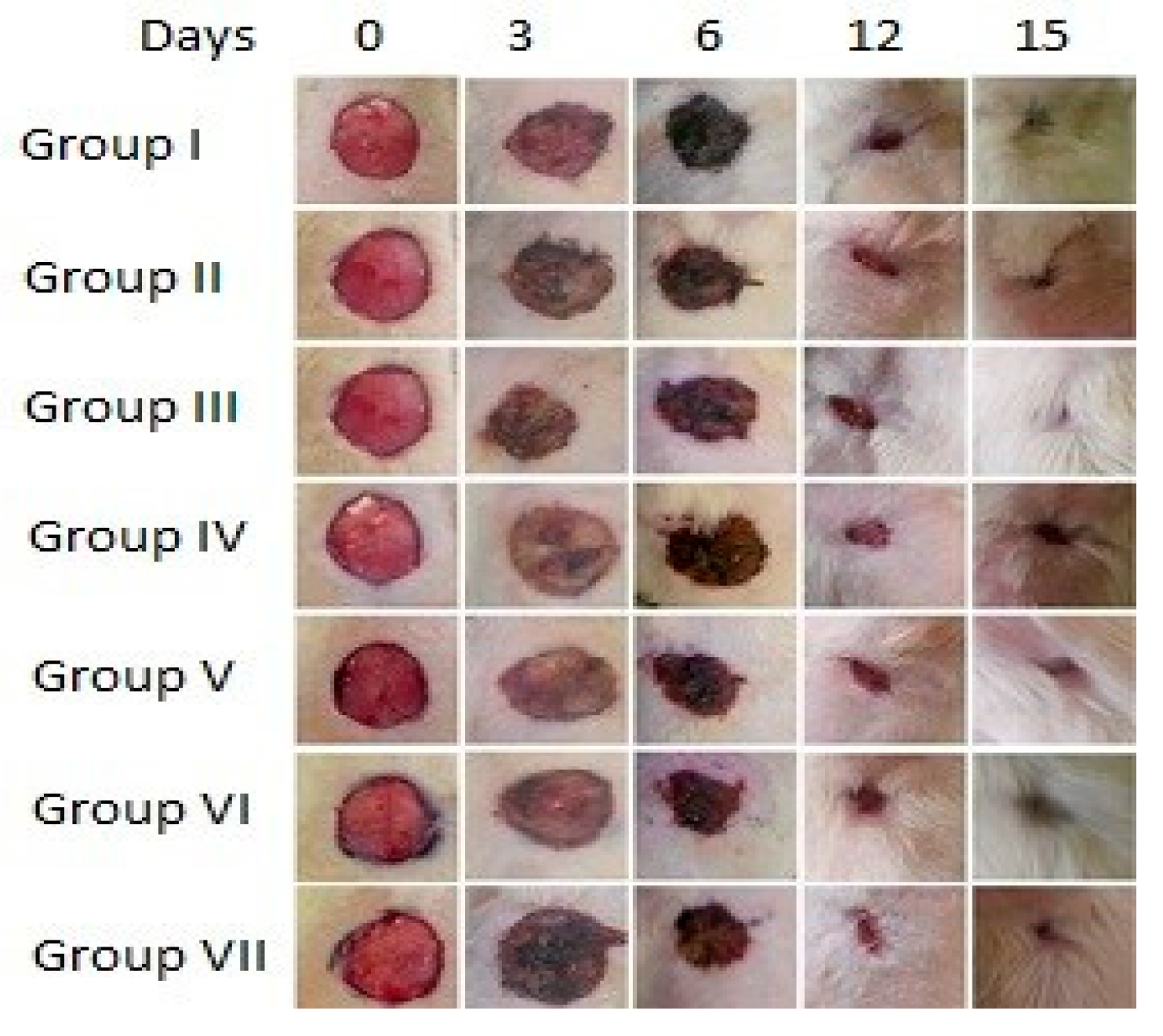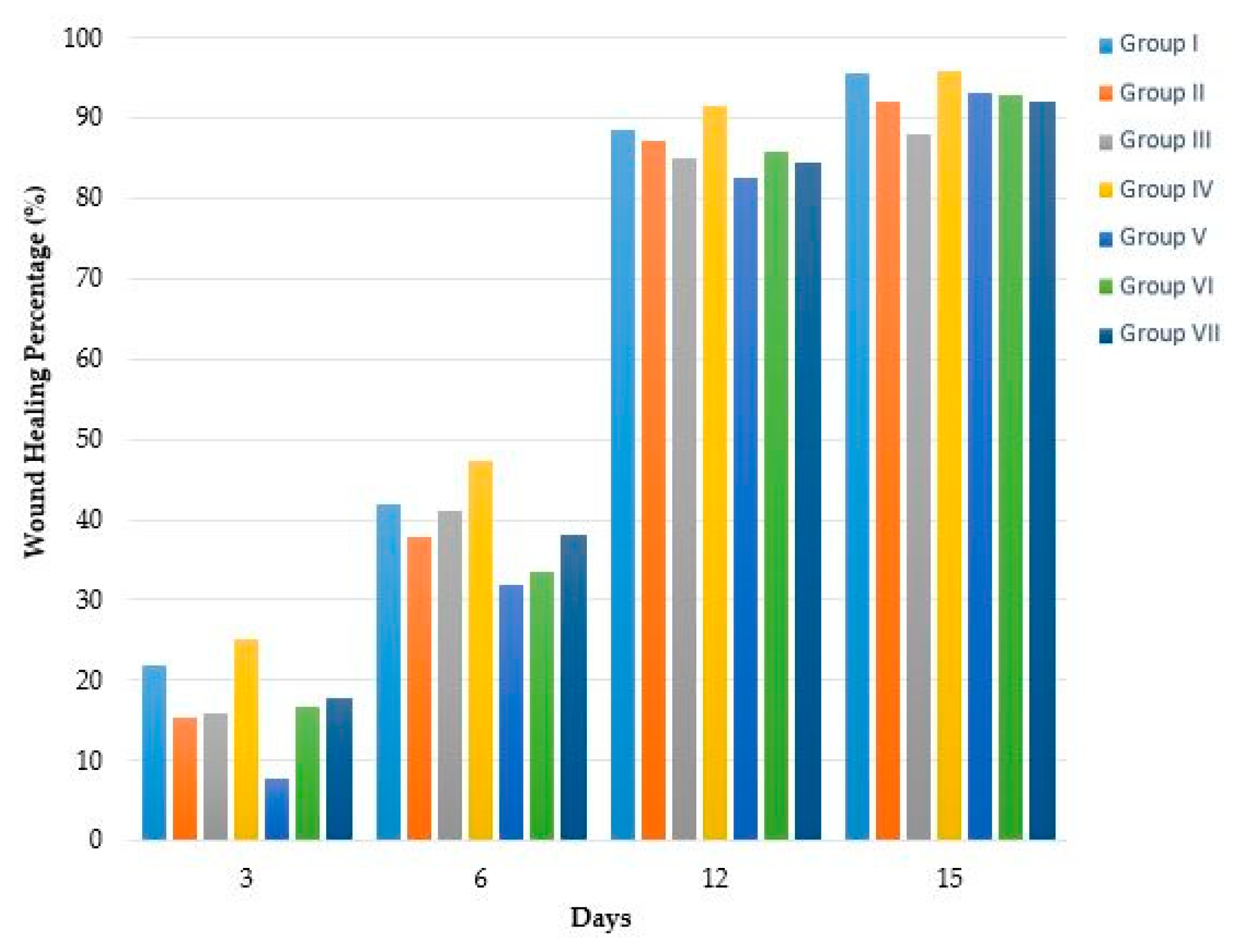Determination of Effect on Cutaneous Wound Healing of Ozonated Hazelnut Oil †
Abstract
:1. Introduction
2. Materials and Methods
3. Results
4. Discussion
Author Contributions
Acknowledgments
References
- Bocci, V.; Borrelli, E.; Travagli, V.; Zanardi, I. The Ozone Paradox: Ozone Is a Strong Oxidant as Well as a Medical Drug. Med. Res. Rev. 2009, 29, 646–682. [Google Scholar] [CrossRef] [PubMed]
- Wu, M.; Church, D.F.; Mahier, T.J.; Barker, S.A.; Pryor, W.A. Separation and Spectral Data of the Six Isomeric Ozonides from Methyl Oleate. Lipids 1992, 27, 129–135. [Google Scholar] [CrossRef] [PubMed]
- Valacchi, G.; Fortino, V.; Bocci, V. The dual action of ozone on the skin. Br. J. Dermatol. 2005, 153, 1096–1100. [Google Scholar] [CrossRef] [PubMed]
- Lezcano, I.; Nuñez, N.; Espino, M.; Gómez, M. Antibacterial activity of ozonized sunflower oil, Oleozón, against Staphylococcus aureus and Staphylococcus epidermidis. Ozone: Sci. Eng. 2000, 22, 207–214. [Google Scholar] [CrossRef]
- Pai, S.A.; Gagangras, S.A.; Kulkarni, S.S.; Majumdar, A.S. Potential of Ozonated Sesame Oil to Augment Wound Healing in Rats. Indian J. Pharm. Sci. 2014, 76, 87–92. [Google Scholar]
- Moghadamtousi, S.Z.; Rouhollahi, E.; Hajrezaie, M.; Karimian, H.; Abdulla, M.A.; Kadir, H.A. Annona muricata leaves accelerate wound healing in rats via involvement of Hsp70 and antioxidant defence. J. Surg. 2015, 18, 110–117. [Google Scholar] [CrossRef] [PubMed]
- Hee, K.; Sun, N.; Won Han, Y.; Kyoung, M.K.; Hoon, K.; Hyung, O.K.; Young, M.P. Therapeutic Effects of Topical Application of Ozone on Acute Cutaneous Wound Healing. J. Korean Med. Sci. 2009, 24, 36. [Google Scholar]
- Werner, S.; Grose, R. Regulation of wound healing by growth factors and cytokines. Physiol. Rev. 2003, 83, 835–870. [Google Scholar] [CrossRef] [PubMed]


Publisher’s Note: MDPI stays neutral with regard to jurisdictional claims in published maps and institutional affiliations. |
© 2018 by the authors. Licensee MDPI, Basel, Switzerland. This article is an open access article distributed under the terms and conditions of the Creative Commons Attribution (CC BY) license (https://creativecommons.org/licenses/by/4.0/).
Share and Cite
Oğuzkan, S.B.; Kaya, S.T.; Cesur, A.; Karagül, B.; Uğraş, S.; Uğraş, H.I. Determination of Effect on Cutaneous Wound Healing of Ozonated Hazelnut Oil. Proceedings 2018, 2, 1537. https://doi.org/10.3390/proceedings2251537
Oğuzkan SB, Kaya ST, Cesur A, Karagül B, Uğraş S, Uğraş HI. Determination of Effect on Cutaneous Wound Healing of Ozonated Hazelnut Oil. Proceedings. 2018; 2(25):1537. https://doi.org/10.3390/proceedings2251537
Chicago/Turabian StyleOğuzkan, Sibel Bayil, Salih Tunç Kaya, Aziz Cesur, Bora Karagül, Serpil Uğraş, and Halil Ibrahim Uğraş. 2018. "Determination of Effect on Cutaneous Wound Healing of Ozonated Hazelnut Oil" Proceedings 2, no. 25: 1537. https://doi.org/10.3390/proceedings2251537
APA StyleOğuzkan, S. B., Kaya, S. T., Cesur, A., Karagül, B., Uğraş, S., & Uğraş, H. I. (2018). Determination of Effect on Cutaneous Wound Healing of Ozonated Hazelnut Oil. Proceedings, 2(25), 1537. https://doi.org/10.3390/proceedings2251537



